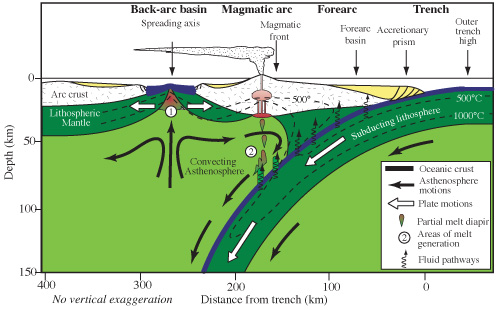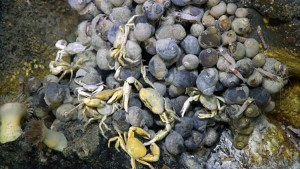24 November 2015
More about the Mariana Hydrothermal Hunt
Posted by lhwang
By Logan Mock-Bunting and Carlie Wiener
This is the latest in a series of dispatches from scientists and education officers aboard the Schmidt Ocean Institute’s R/V Falkor. This November, scientists aboard the research vessel Falkor will aim to shed light on the Mariana Back-arc, which is expected to be teeming with activity and life. Over the course of their 27 day mission at sea they will explore the back-arc spreading center to find new sites of hydrothermal activity and to better understand the physical, chemical, and geological forces that shape biodiversity in these unique ecosystems. Read more posts here, and track the Falkor’s progress here.
The Mariana region, famed for boasting the deepest spot on the planet, is also home to the Mariana subduction system. This mash-up of tectonic plates includes a wide range of geological settings and marine habitats, including a very deep trench, a shallow volcanic arc, and a mid-depth back-arc spreading center. This great diversity of settings and habitats makes the Marianas a valuable natural laboratory for testing ideas about the distribution of animal species within hydrothermal vent ecosystems.
In the Mariana region, only the volcanic arc has been systematically explored for hydrothermal vents, resulting in the discovery of 20 hydrothermally active seamounts and over 20 new species. These remarkable discoveries directly inspired the establishment of the Marianas Trench Marine National Monument in 2009. In contrast, more than 1000 kilometers of the Mariana back-arc remains almost completely unexplored.

Cross-section through the shallow part of a subduction zone showing the relative positions of an active magmatic arc and back-arc basin, such as the southern part of the Izu-Bonin-Mariana Arc.
Credit: Licensed under CC BY-SA 3.0 via Wikipedia
Focusing on the Back-Arc
This November, scientists aboard Falkor will aim to shed light on the Mariana back-arc, which is expected to be teeming with activity and life. Principal Investigator Joseph Resing, of the University of Washington, will lead a team of researchers from the University of Washington, Oregon State University, and NOAA/PMEL, over the course of the 27 day mission at sea. Their goal is to explore the back-arc spreading center to find new sites of hydrothermal activity and to better understand the physical, chemical, and geological forces that shape biodiversity in these unique ecosystems.
Life in the Shadowy Depths
These researchers expect that the Mariana back-arc should host many sites of hydrothermal activity with chemosynthetic ecosystems. “Chemosynthesis” refers to organisms that transform carbon dioxide into organic matter in the same manner as plants, but, instead of using the energy from sunlight to do this — as in photosynthesis — they use chemical energy instead, mostly from hydrogen, methane, hydrogen sulfide, and iron. Chemosynthetic ecosystems exist in locations on the seafloor where chemical energy is present from seafloor hot springs, cold seeps, or other microbiological processes.
Shaping Earth, Shaping Life
The Mariana subduction system offers living organisms a range of conditions unlike any other region on the planet. During subduction, two of Earth’s tectonic plates collide. However, instead of crashing into each other and crumpling like a car wreck, one of the plates dives beneath the other, producing a deep trench. The down-going plate causes melting in the overlying mantle, creating magma that feeds the active volcanoes of the overlying arc. Further to the west, the back-arc is a zone of spreading in the overriding plate, where mantle magmas well up and new ocean crust is formed. For the chemosynthetic ecosystems, each of these tectonic environments create different geophysical and geochemical conditions. These differences seem to be reflected the diversity of biological communities on the seafloor.
The Right Tools
Searching for hydrothermal vents is not an easy task due to the technical challenges of working in the deep ocean. The team plans to use the Sentry Autonomous Underwater Vehicle (AUV), as well as instrument packages consisting of optical and chemical sensors to survey systematically for hydrothermally active areas. These sites could hold the answers to fundamental questions about the relationships between ecosystems, geologic settings, and fluid geochemistry.
Identifying vent sites
The research from this cruise will help test the idea that arc and back-arc sites have distinct ecosystems, controlled by each settings’ geology and unique fluid chemistry. It order to test this hypothesis, several tasks must be accomplished. The science team will start by finding and identifying active vent sites along the Mariana back-arc, and will characterize each site by its depth, geologic setting, temperature, chemical composition, and rise heights of hydrothermal plumes. During a follow-up expedition next year, the scientists with return with a remotely operated vehicle (ROV) to visually explore and sample the new vent sites on the seafloor.

Snails, crabs, shrimp, and anemones at a hydrothermal site.
Credit: Submarine Ring of Fire 2014 – Ironman, NSF/NOAA, Jason, Copyright WHOI
The science team is likely to find some surprises given how little exploration has been done on the back-arc and anticipates finding several new sites. We consider the Mariana system as a natural laboratory where hypotheses about the interrelations between tectonics, biodiversity, and biogeographic patterns can be tested. After constructing a geological and geochemical model of the back-arc vent settings, the team plans on combining the model with biodiversity data, to better define the relationships between geologic setting, chemical environment, and biological communities.
Support for research related to this expedition is provided by NOAA Pacific Marine Environmental Lab (PMEL), NOAA Office of Ocean Exploration and Research, NOAA Pacific Island Regional Office, University of Washington, and Oregon State University. Schmidt Ocean Institute provides ship time aboard Falkor and the equipment required at no cost to our collaborators.
— Logan Mock-Bunting is the Outreach Communications Specialist and Carlie Wiener is the Communications Manager at Schmidt Ocean Institute






 GeoSpace is a blog on Earth and space science, managed by AGU’s Public Information staff. The blog features posts by AGU writers and guest contributors on all sorts of relevant science topics, but with a focus on new research and geo and space sciences-related stories that are currently in the news.
GeoSpace is a blog on Earth and space science, managed by AGU’s Public Information staff. The blog features posts by AGU writers and guest contributors on all sorts of relevant science topics, but with a focus on new research and geo and space sciences-related stories that are currently in the news.